Yes, Anthony Fauci and other major research officials tried to suppress the lab origin hypothesis for Covid origins; and yes, a conflicted group of scientists tried to help them [Updated July 19]
A trove of new documents, some revealed by a Congressional subcommittee, point to political motivations rather than science for dismissing a lab origin. A hearing on Tuesday accentuated the issues.
In Marc20, the same month it became clear that the United States would not be spared the COVID-19 pandemic quickly spreading around the world, five scientists published a pivotal letter in the journal Nature Medicine: “The proximal origin of SARS-CoV-2.” By that time, Donald Trump, some of his associates (eg Steve Bannon), and some members of Congress (eg Senator Tom Cotton) had already begun pointing the finger at China, not just as the obvious epicenter where the pandemic began, but as possibly responsible for a lab accident that might have led the virus to escape. The lab in question, of course, was the Wuhan Institute of Virology (WIV); it was uncontested that Wuhan is where it all began, except in the view of the Chinese government, which has sometimes claimed it all started at a U.S. lab.
The previous month, another highly influential letter was published in The Lancet, calling a lab origin scenario a “conspiracy theory,” a term that some scientists and journalists continue to use today for a hypothesis that most scientists—and the World Health Organization along with all U.S. intelligence agencies—consider to be plausible. The Lancet letter, it would later be revealed, was secretly organized by Peter Daszak, president of the New York-based organization EcoHealth Alliance, which had funneled research funds to the WIV and closely collaborated with its scientists, including the famous “Bat Woman” Shi Zhengli.
But while the Lancet letter was generally understood to be opinion, the Proximal Origin publication was advertised—including by Anthony Fauci, who mentioned it during a White House briefing—as the best and most current scientific evaluation of COVID-19 origins by some of our best and brightest scientists. It was hugely influential and very widely cited, as was its bottom line conclusion: “…we do not believe that any type of laboratory-based scenario is plausible.”
Such a sweeping statement might have put the matter to rest, but there was a problem: For a variety of reasons, ranging from the pandemic’s origins in the city with the world’s most famous bat coronavirus research lab, to certain features of the virus’s genome—some scientists thought a lab origin could not be so easily dismissed. Indeed, an analysis of the paper by two scientists asked by the Department of Defense to examine it took issue with nearly all of its logic and conclusions. (This document, like many others relevant to COVID-19 origins, was uncovered by the independent investigative group DRASTIC.)
But from the beginning, the lead author of the paper, Kristian Andersen of the Scripps Research Institute in La Jolla, California, fiercely defended the paper. He did a lot of that on Twitter, engaging in the kind of toxic trolling that has often characterized the debate. Meanwhile, reporters and other investigators, using the Freedom of Information Act, uncovered emails by Anthony Fauci and other officials and scientists that revealed the Proximal Origin paper had originated in what might be called high level discussions with men in control of many millions of dollars of funding. Those revelations led to accusations that the Proximal Origins authors had sold their scientific souls, and that the paper had been orchestrated by Fauci et al. to squelch the lab origin hypothesis.
Last Tuesday, Andersen and another Proximal Origin author, Robert Garry of Tulane University in New Orleans, testified before the House Oversight Select Subcommittee on the Coronavirus Pandemic, where members of the Republican majority questioned them closely on allegations that they had thrown the science to please Fauci, along with then NIH director Francis Collins and then Wellcome Trust director Jeremy Farrar. At the same time, the majority staff released a 55-page report complete with documents and testimony to bolster its case (the Democratic minority released its own 22-page report taking issue with those conclusions.)
At the hearing, Andersen and Garry (who were not sworn under oath, but informed that lying to Congress is a felony) stuck to their story that they had been motivated by nothing other than science in the preparation of Proximal Origins. But before I proceed, I’d like readers to take a look at the top of this post to see the Slack messages dated February 2, 2020, between Andersen and another of the paper’s authors, Andrew Rambaut of the University of Edinburgh, which were quoted in the majority report. Two other authors were part of that exchange as well. In the discussion, Rambaut talks about the “shit show” that would take place if anyone accused China even of an accidental lab release. Andersen agrees, stating that he hates injecting politics into science, but in this situation “it’s impossible not to.”
In a moment we will have a look at a longer exchange between Andersen and Rambaut in which they readily concede that the science is not at all certain, and that again, politics played a major role in the creation of Proximal Origins.
But first let’s go back to the previous day, February 1, 2020. The whole thing started innocently enough, when Andersen contacted Fauci to express his concerns that the new virus might have come out of a lab. In the following email, obtained via the FOIA by independent journalist Jimmy Tobias and published previously, Fauci reports the conversation to Farrar of the Wellcome Trust. Please observe a note of alarm in Fauci’s email, which suggests that U.S. and British intel agencies should be alerted:
As previously documented, Fauci, Collins, Farrar, Andersen, Rambaut, and other scientists met for a conference call on February 1 to discuss the matter. Here is Fauci’s report on how that went, just released this week by the Subcommittee. Note that Fauci is clearly aware that so-called gain-of-function research with bat coronaviruses had been going on in Wuhan; in fact, this own agency, NIAID, had been funding just such research:
But, as indicated in the banner image above, Andersen and Rambaut continued to discuss both the political and scientific issues on Slack. The following exchange, part of Slack messages produced to the Subcommittee by Andersen, gives the tenor of their thinking, still on February 2. It’s a little hard to read, because it was not part of the Subcommittee’s public release—internet sleuths dug it out from what was supposed to be redacted portions of pdf files that were released. But if you look carefully, you will see that the scientists did not think a laboratory origin had been ruled out, nor did they think it could be given the state of evidence at the time. Nevertheless, since a natural origin (zoonotic spillover) was equally plausible, and a lab origin could not be proven, they were already deciding to simply go with the natural explanation.
Andersen has tried to explain how he went from thinking that the virus might be engineered—remember that he shared those concerns with Fauci at the very beginning of the episode—to concluding a lab scenario was not plausible in just a few days, as just an example of the normal scientific process. But in fact, as demonstrated in this February 20, 2020 email to an editor at Nature, where the manuscript was first submitted, at that time he really thought a lab origin could not be refuted and that it was a serious scientific hypothesis and not at all a “conspiracy theory.”
Presumably his views had still not changed when, after Nature rejected the paper for reasons I will not get into here, it was finally published in March in Nature Medicine. In other words, Andersen, who was lead author of the paper (and possibly other authors as well, including Rambaut) published a paper stating a lab origin was not plausible when his own scientific analysis had concluded that it was. Even worse, as Andersen writes, the team had “really, really” wanted to refute the lab origin hypothesis, and in fact, that is what they had set out to do in the first place.
So now let’s go back and look at more of the context for all this. As revealed in the FOIA documents and discussed in the majority report, among the scientists the group consulted was Ron Fouchier, a researcher at Erasmus University in the Netherlands infamous for earlier gain-of-function work with the dangerous avian flu virus (controversy over that work had led to an NIH moratorium on gain-of-function research for three years, 2014-17.) As the documents show, Fouchier was very concerned about the effects a lab origin conclusion for the pandemic virus might have on the future of gain-of-function research (he turned out to be prophetic on that score):
In the same email from Fouchier, not reproduced here, he also argued that the SARS-CoV-2 virus could not have been created at the WIV because it was very unlikely they had any kind of precursor virus in the lab that could have been turned into it. But Andersen, in his discussions with Rambaut and other authors, rejected that assertion, on the grounds that the Chinese researchers could have fairly easily created such precursors, especially since they had a long history of creating chimeric SARS-like viruses and experimenting with them over the years. But the published version of Proximal Origins explicitly adopted Fouchier’s argument, despite Andersen and the others knowing better:
“Furthermore, if genetic manipulation had been performed, one of the several reverse-genetic systems available for betacoronaviruses would probably have been used19. However, the genetic data irrefutably show that SARS-CoV-2 is not derived from any previously used virus backbone20”
And the evidence, again from FOIA documents, shows that Fauci himself was aware of one scenario that could have led to a lab release: The use of so called “humanized” mice as subjects in infection experiments to see what changes in SARS-like viruses might lead them to infect humans and possibly create a pandemic—work that WIV scientists had done in collaboration with U.S. scientists and with support from Fauci’s own NIAID:
Moreover, as early as February 2, the emails show, Fauci was already expressing concern with political ramifications (“the threat of further distortions on social media”) and arguing that the group needed to do something quickly to squelch them. (In the email below, Fauci rejects Ron Fouchier’s suggestion that they should do nothing at the time.) Indeed, this scientific rush to judgment can be dated to February 2, as political ramifications began to take front seat:
At this point, Collins and Farrar appear to take over the effort, setting into motion the preparation of the Proximal Origins paper:
But when WHO showed it was not in any hurry to move on the issue, Farrar put his foot on the gas. Within 10 days, he had taken the lead, as Fauci stepped back:
Andersen and the other Proximal Origins authors continue to insist to this day that they independently drafted the paper and none of the higher-ups had anything to do with it. But again, the documents say otherwise. The following is an excerpt from the Subcommittee’s interview with Ian Lipkin of Columbia University, who apparently was added as an author later because of his experience in China. Note that Farrar clearly appears to be vetting who is going to be an author on the paper. (Eddie Holmes, another author, is a scientist from Australia who had long collaborated with the WIV.)
In this email, Holmes tells the group that there had been a last minute rush to get the paper ready because of “pressure from on high,” and also that Farrar and Collins had been “very happy” with the paper. Any assertions that the team was working independently of the higher-ups is flatly contradicted by these statements:
This finds some confirmation in this segment of the Subcommittee’s interview with Michael Farzan of Boston Children’s Hospital, whom Andersen consulted about some of the science of coronaviruses:
But in the years since the paper was published, Andersen has routinely attacked anyone who disagrees with its conclusions as a “conspiracy theorist,” even though the record is clear that he disagreed with the paper himself:
So what are we to think about all this? The facts of the case, and the exquisite defensiveness of Andersen over the past three years—as demonstrated in many Tweets very similar to these—suggest that he and at least some of the other authors know full well that the conclusions in Proximal Origin were based more on what the major funders—Fauci, Collins, and Farrar—wanted to see than on solid science. Some have even argued that Andersen’s leadership in the production of the paper was a quid pro quo for a big grant proposal he had pending with the NIH.
I think the explanation actually goes broader and deeper than that. First of all, even very senior scientists depend on powerful grant funders for their research and continuing careers, such that a quid pro quo is actually built into the structures of science itself. And we must remember the period of time all this was going on, when the pandemic was already becoming highly politicized and Fauci was being hailed as a champion of science against the obstructionist know-nothingness of Trump and the Republicans. For many scientists, and science journalists, pointing the finger at China was a deflection from what needed to be done to stop the pandemic, which the Trump administration was largely failing to take seriously.
But for Fauci and Collins, in particular, there was the very real fear that research they had funded in Wuhan might actually have led to the pandemic. The consequences of that would, of course, be very serious in many different ways—another reason that some scientists, especially virologists, have so virulently attacked the lab origin hypothesis and scientists who think it plausible or likely.
Instead of rushing out a very flawed paper like Proximal Origin, with its scientific flaws and highly motivated reasoning, the group should have launched a research project to figure out how the pandemic began. (And journalists for major media should have followed suit.) Instead, they put out what can only be described as propaganda masquerading as science. We have been suffering the consequences ever since.
To end on a positive note, however, the plan to squelch a serious investigation into COVID-19 origins has failed, badly. Thanks to independent journalists and investigators, and scientists with integrity, the search for the truth will go on.
Update June 19, 2023: Andersen continued to say privately lab origin was possible a month after Proximal Origin was published.
Since the above was published, new Slack messages involving Kristian Andersen have come to light. A very revealing one was included in a story on the Proximal Origin background published by the Substack newsletter Public. The authors reproduced a remarkable message from Andersen dated April 16, 2020, a full month after the letter was published in Nature Medicine. Here it is, with apologies that I cannot format it to be any larger:
In this message, apparently written to Andrew Rambaut, Eddie Holmes, and others, Andersen continues to state his view that a lab accident was entirely possible, and even provides scenarios for how it might have happened. He also expresses some skepticism about an interview Shi Zhengli, the famous “Bat Woman” of the Wuhan Institute of Virology, gave to journalist Jane Qiu for a profile in Scientific American. In other words, Andersen, who was already publicly accusing anyone entertaining the possibility of a lab origin a “conspiracy theorist,” realized in private that it was entirely plausible, contrary to what he wrote in Nature Medicine. I will leave it to others to comment on what the consequences of such double-dealing should be.







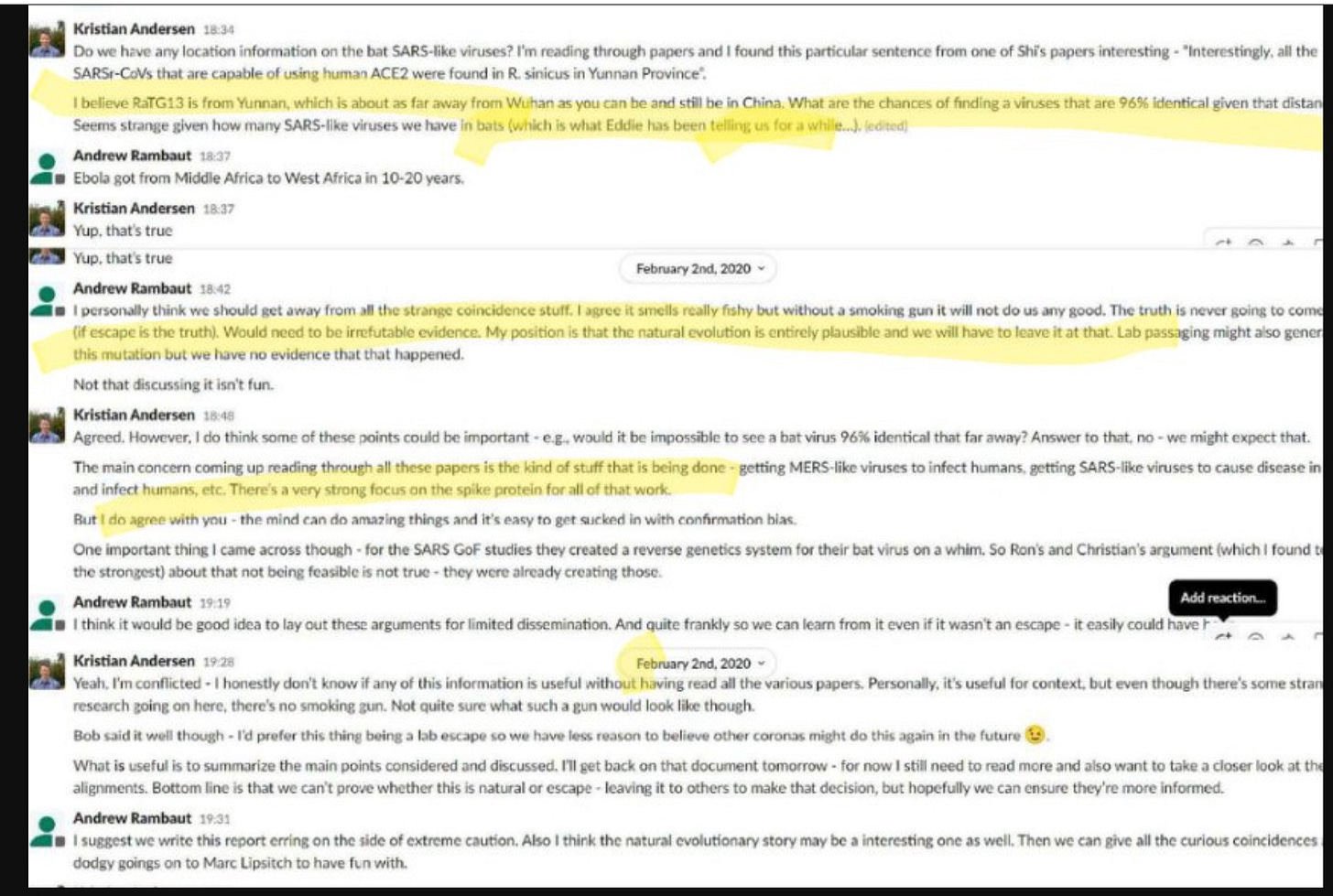


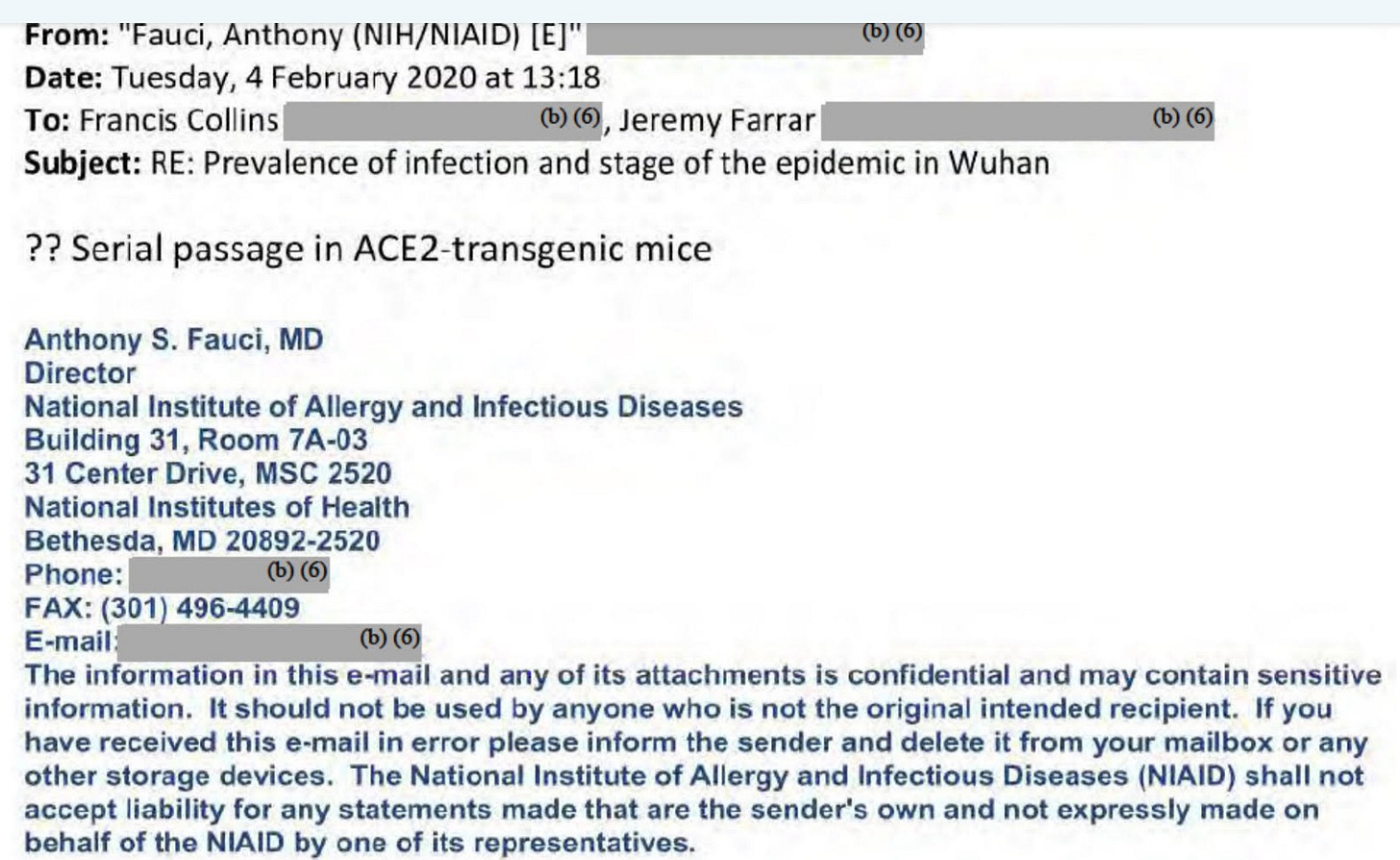
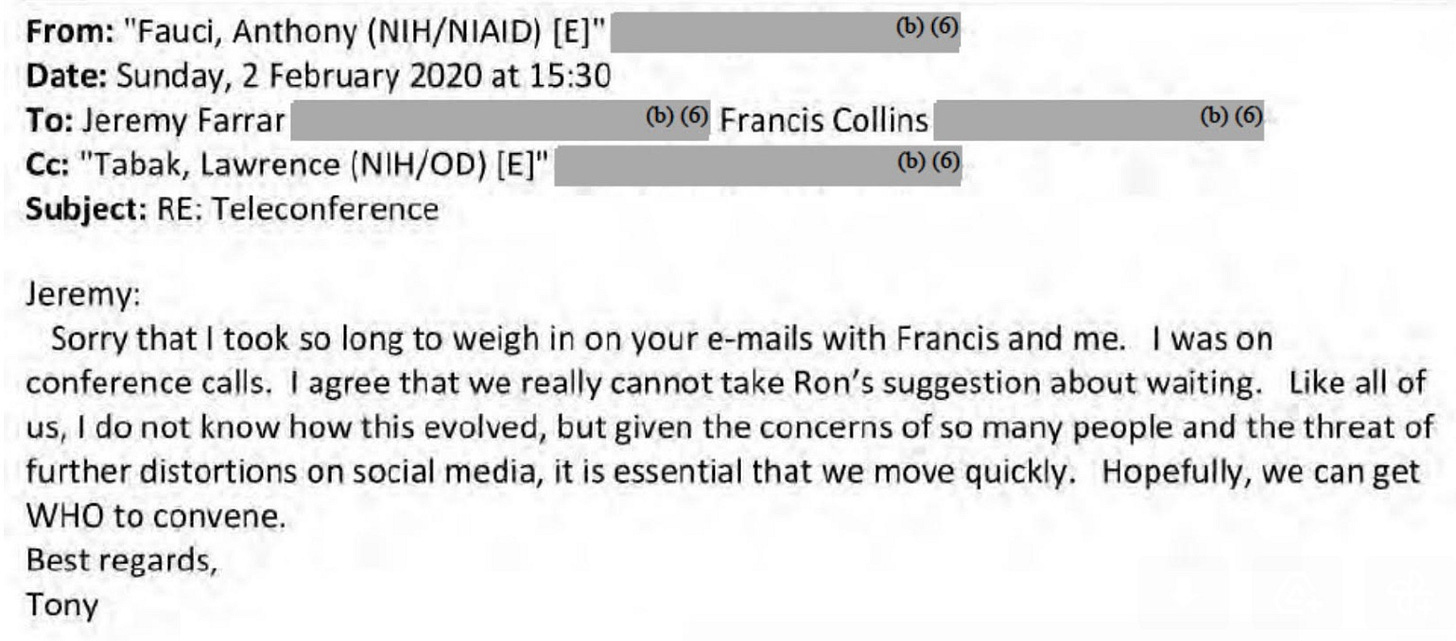

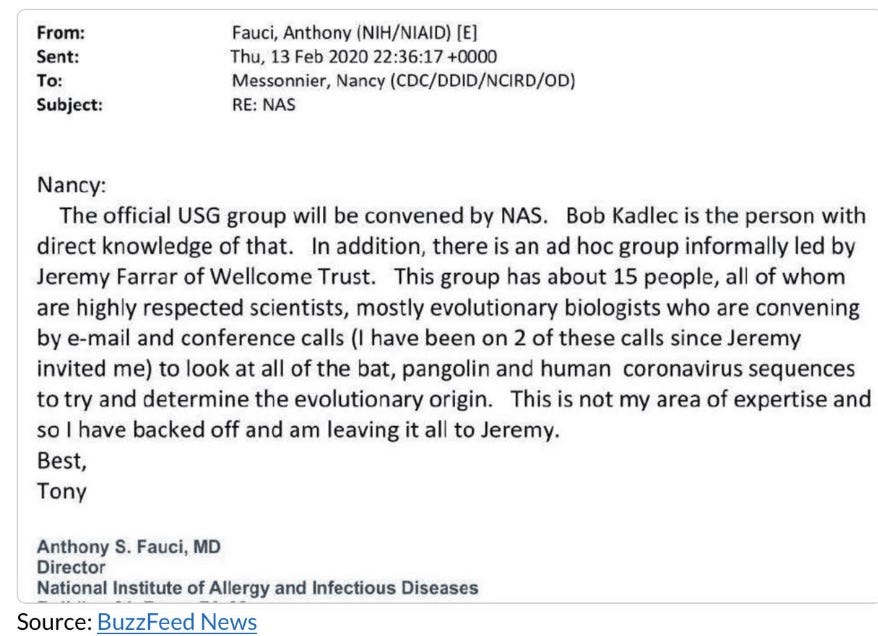
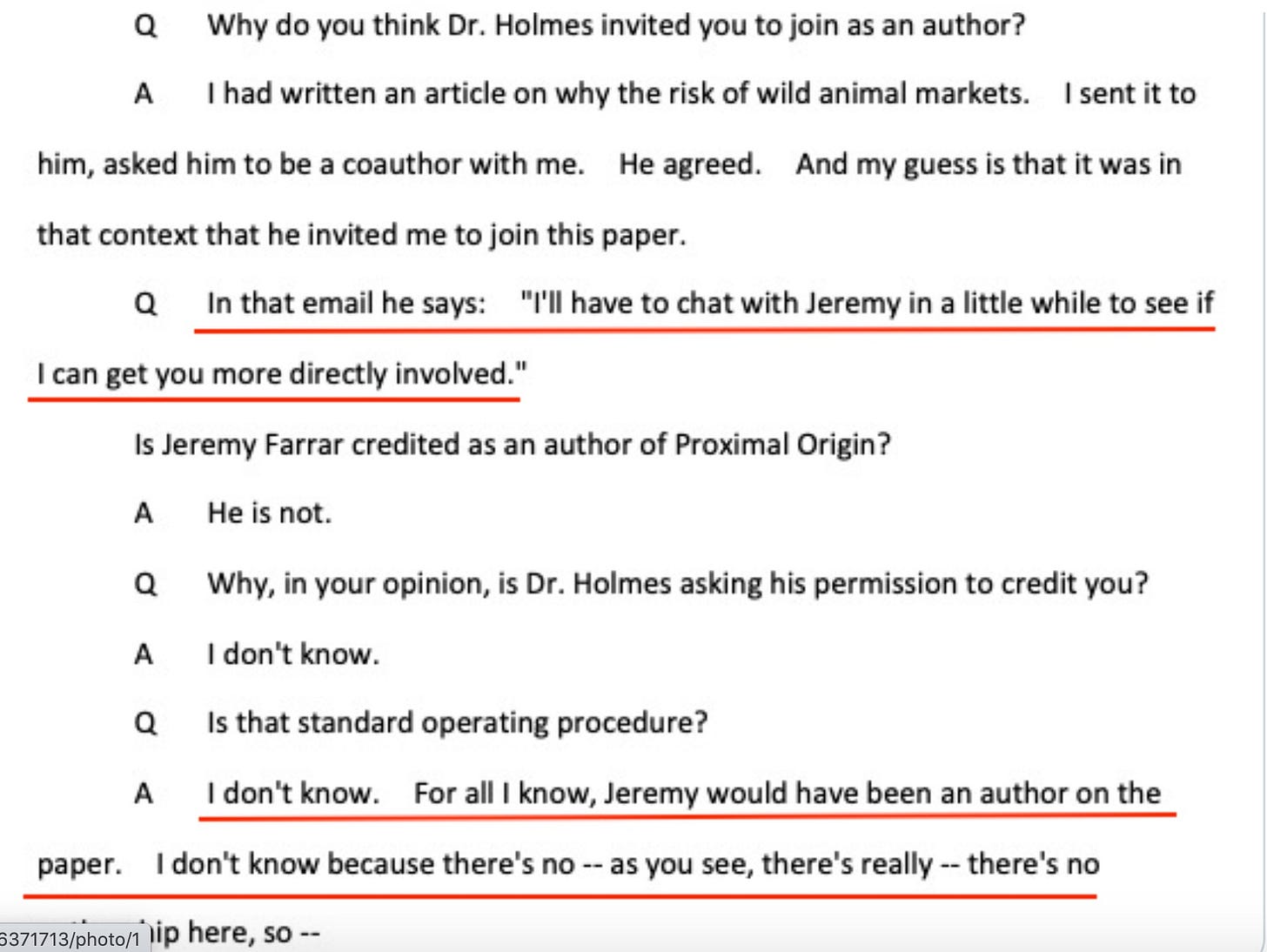
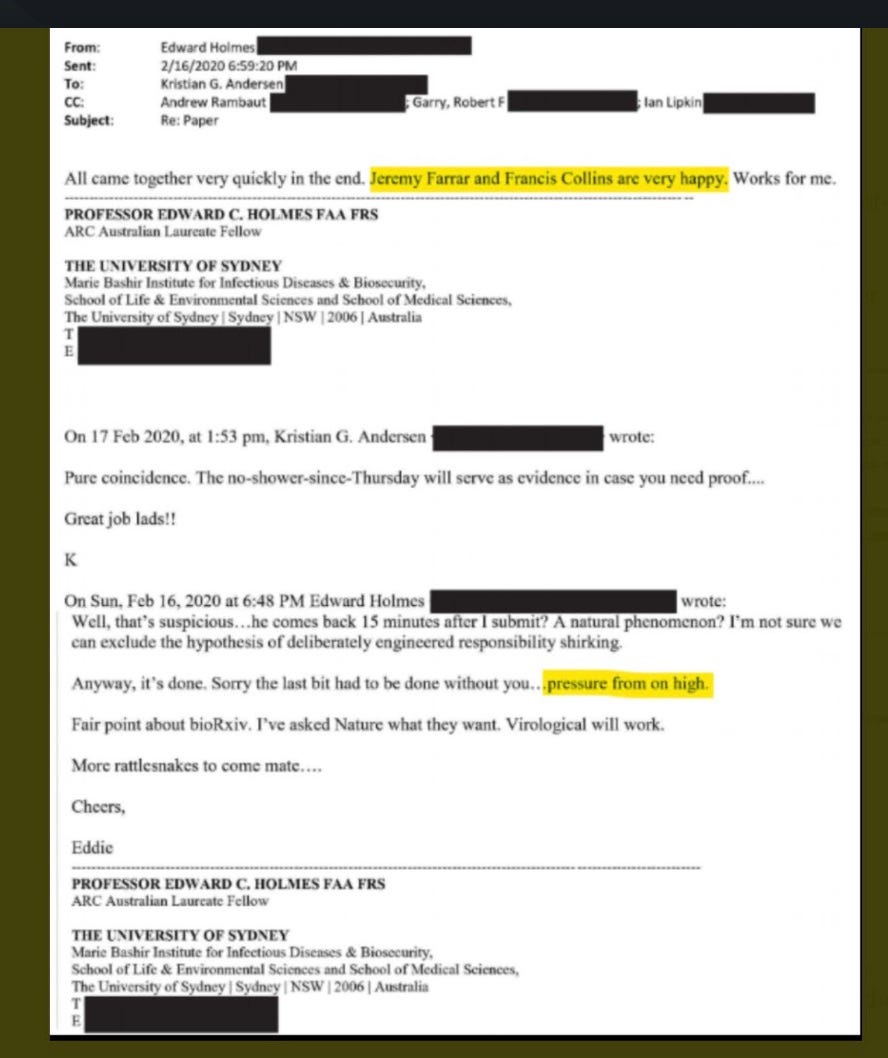

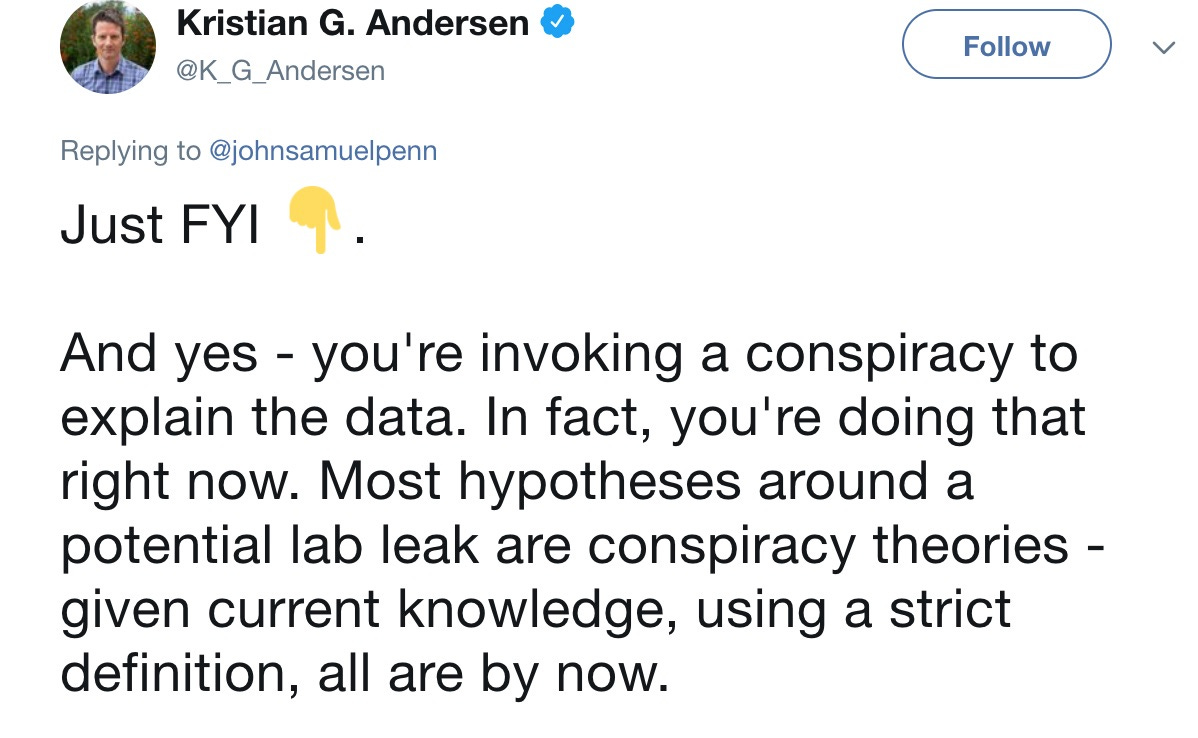
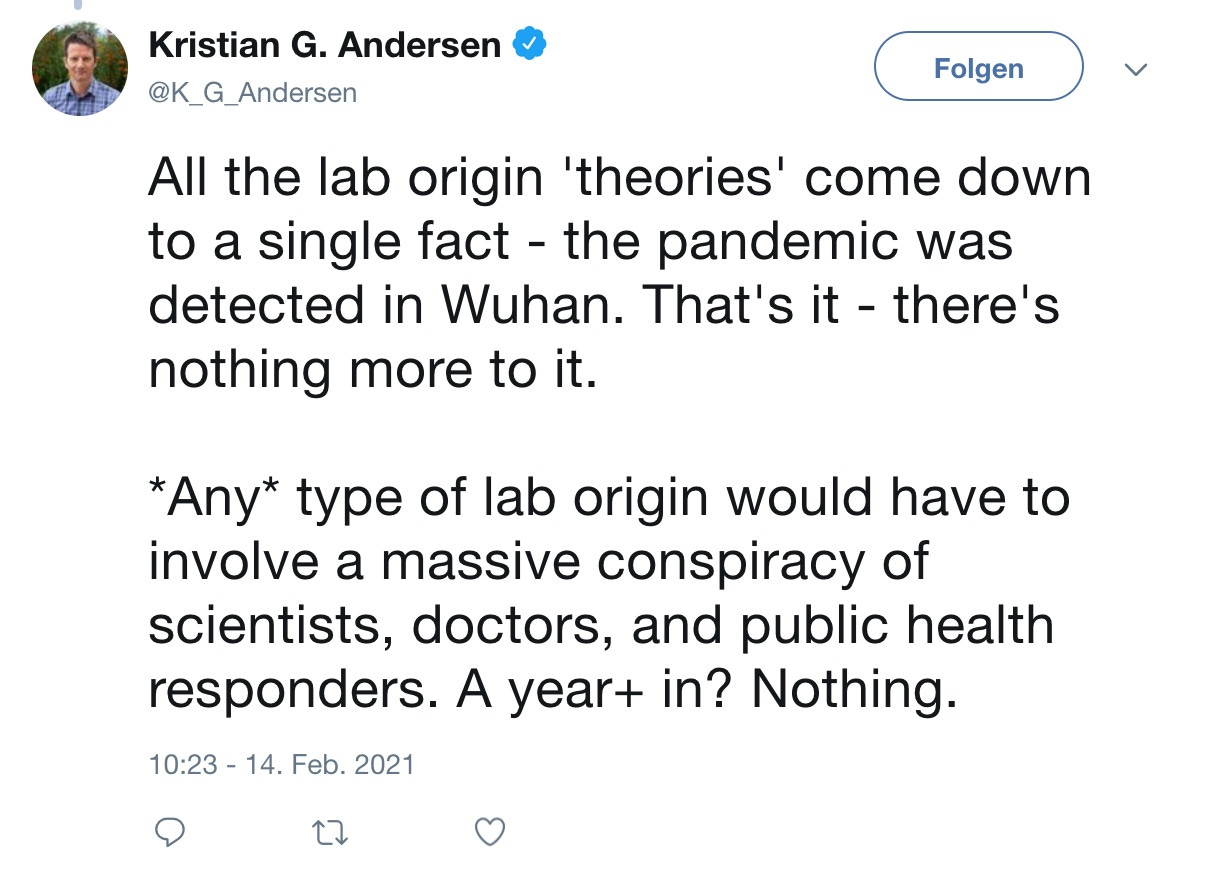

Great article.
Yes, the cover up failed, but there have been few consequences to the liars.
The culture of mendacity prevailed for years and ordinary citizens were once again reminded that they exist only to fund the elites.
Thank you. Some credibility restored.